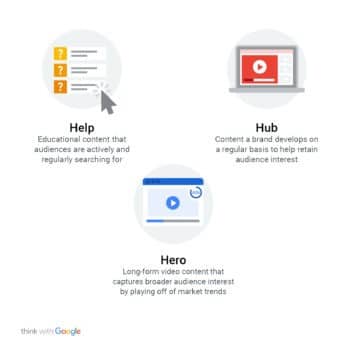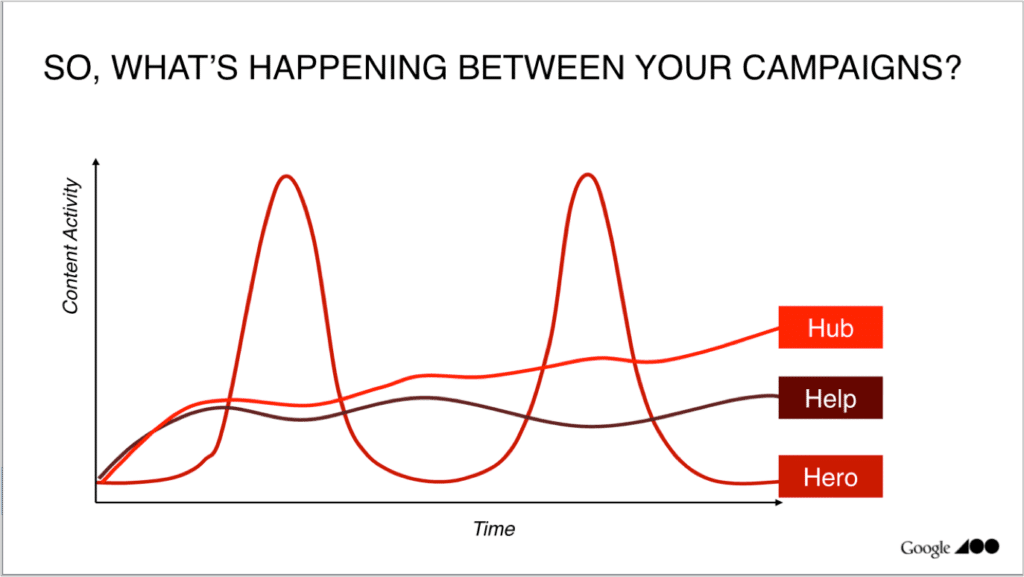
image credits: https://www.thinkwithgoogle.com/
(this article talks about a concept we use in our class, applied by students at the end of the 1st day to start developing content strategy for their company/business)
In the last ten years or so, we have seen a relentless trend of developing a new approach to building brands and earning attention of the consumers/clients: the so called ‘Content’ approach. Traditional ‘interruption’ paradigm of what my former Lexus client called ‘the glamorous monologue of advertising’ – when companies interrupt consumers in watching or reading something they want to watch with their ads, which they do not neccessarily want – is on the wane in the digital space.
The reasons are multiple:
- An ever-increasing time we spend on various digital screens (sometimes several at the same time) has created what Google calls the ‘skippable world’ in which companies have to, more and more, try to earn the attention of their audiences, not just try to buy it. Just buying is now not a very effective way to go and promote a brand (even he expression ‘promotion’ is now frowned upon, as Unilever – the 2nd largest advertiser in the world, does not use the word anymore, replacing it with ‘Content’ in their 5C model of brand building).
- There is a spectacular amount of wastage in traditional advertising practices when they move to digital screens (slightly better in social media), with up to 54% of the online display ads not reaching even the IAB ‘viability standard’ of at least half of the ad being on the screen at least 1 second!
- Finally, online ads, especially outside of the social media ,are increasingly blocked and ignored. Some statistics show the average global CTR (click through rate) of only 16 clicks per 10,000 impressions! Not a very good deal, it seems, for many…
No wonder then that the Content paradigm is on the rise (under another name of ‘storytelling’, as reflected in the spectacular rise of job titles containing this word). Content is now King (but context is stil God…), a rising approach which, when done properly, allows a brand/company to become what people want to watch or read, to let onto their screens and into their battered attention spans. Content moves the whole marketing communications game from push to pull.
But, what is Content? As explored in more details in the book I co-wrote with Justin Kirby a few years ago, there are many definitions and attempts to conceptualise and articulate this space. My favourite framework, adopted by numerous companies across the world is You Tube’s ‘3H’ model.
How does it work and why every company and marketer, whether consumer or corporate, commercial or CSR (especially corporate comms people) should know about it?
The 3H stand for the Hero, Help and Hub. It is based on a massive research that Google performed some years ago on how people use You Tube, but then cofirmed that this is also largely how people use the Internet.
Hero is things we know so well: big moments of storytelling we share with friends, we talk about at watercoolers, we use as examples of great creativity, if and when created by and for brands. The Nike extravaganzas, the Wren kisses, the Dove Sketches humanity, the Always ‘like a girl’ prejudices and the Volvo Van Damme ‘split’ humbugs.
Hero content – almost always video, unless we are Oreo ‘dunking in the dark’ – is what ‘traditional’ creative agencies eat for breakfast. It’s a permission for a brand to behave like a broadcaster or an entertainer, amplifying its message through big ideas and adequate supporting spend. And without restrictions of expensive TV seconds. It is the Hollywood kind of fame, the blockbuster fame, usually earned through cinematic jewels that last minutes. Long time ago, we used to call it ‘virals’
On the other end of the spectrum lies the Help content. It is the land of ‘influencers’ and a growing number of ‘immigrant’ brands who are either mimmicking or partnering them. The amount of Help content not just on YouTube, but on web overall, eclipses everything else.
Help is, simply, content people look up when they need help with something, when they want to learn. It is tutorials and ‘how to’ videos and articles. How to set up their sustainability strategy, learn what is Content marketing, braid a particular kind of plait, how to make a perfect crocodile BBQ, how to learn Serbian or how to achieve a specific make-up look. It’s a permission for a brand to behave like a friend, to guide, to earn trust. It is also the BBC kind of fame, the documentary fame of someone who really, deeply understands people’s needs around a particular issue, category or a product. Unilever surfs the Help wave in a textbook fashion with its ‘All Things Hair’ channel.
Finaly, once a consumer comes into a brand’s gravitational field, by discovering it either through Hero or Help content, she may like what she saw and may want more; she clicked on the ‘Subscribe’ button; she may have give us her email address or a mobile phone number; she is expecting regular doses of magic. Do you have it? If you do, then you have activated the Hub strategy layer. A Hub could sit on your website, or on You Tube, or could be a group of interested people discussing topics on Linked In or on Facebook. You can create it, sponsor it or even take it over.
The Hub is where the digital celebrities are made, the stuff of ‘formats’. And it is still not very populated by brands. It is episodic content, created and launched in regular instalments, based on a specific field of interest and on what a brand or an infuencer have to say about it. The Hub content is a permission to be a fellow nerd, to explore the sweet spot where people’s interests meet a brand’s competence and a unique tone of voice, indigenous to brand or borrowed from influencers. It is the HBO kind of fame, the stuff of serial storytelling.
The 3H model has transformed how many companies organise their communications efforts and how they increase chances if being let into the screens of their audiences. It is the basis for the so called ‘heartbeat’ approach to planning company communications, as depicted in the chart below: a constant ‘hum’ of the Help and Hub activities, punctuated by the ocassional Hero bursts.
Now we know what Content means!


